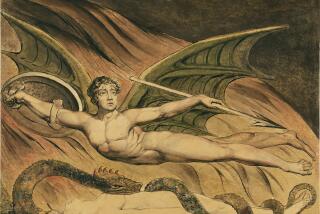ART REVIEW : Drawing Conclusions From the Lives of Renaissance Men
As an extension of the J. Paul Getty Museum’s energetic collecting of high-quality manuscripts, Thomas Kren, the museum’s young and keen-eyed curator of medieval manuscripts, has put together a show that samples illuminated manuscripts and their patrons. “Vie a Mon Desir”: Illuminated Manuscripts and Their Patrons” continues through July 2.
During the Middle Ages, the major patron for illumination was the church and book illustration was restricted to monasteries and ecclesiastic subjects. As the renaissance arrived, with all its rich and princely nobles and urban centers, patronage was extended to include some of the most powerful and elite names in history. Book execution fell from the hands of monks to premier artists sought mainly for their skill at illustrating everything from the standard prayer books to romantic histories to fencing manuals. (A charming one that outlines moves and combatants in black and white contour lines is included here.)
The premise behind the show is that these little books present an interesting way to delve into the social, political and economic goals of patrons. That’s a tremendous load to put on a mere 18 delicately painted pages of parchment, spectacular as they may be.
But the relationship between the codex and its wealthy sponsor is pretty obvious: The richer the person, the finer the artisan and the more tour de force the product. As you might expect, powerful and probably somewhat egotistic rulers like Duke Philip the Good of Burgundy (whose sponsorship is sampled in the very fine “History of Charles Martel”) had themselves lauded in their manuscripts either by showing their pious acts, close proximity to saints, or with their substantial worldly possessions never too far away.
All these subtle and not so subtle prejudices of patron (and sometimes artisan) seep into these beautiful creations, but ultimately the show doesn’t need a thesis to persuade us that it is an excellent, thoughtfully amassed anthology of illumination from the 11th to the 16th centuries.
This exhibition scores on its variety of hands and its consistent quality. A 12th-Century New Testament illumination of St. Luke floating in a pure gilt field and draped in classical robes shows the regional influence of Byzantine mosaics. A jagged, Gothic-ly rendered St. Hedwig, canonized wife of Henry I, graces the page of a book ordered by one of the saint’s very distant descendants, who shows himself in knight’s armor with his richly attired wife praying at the foot of their famous relative.
Kren aptly titled the show “Vie a Mon Desir” (Life According to My Desire) after those words inscribed in a gorgeous book of hours commissioned around 1455 by Simon de Varie, who shows himself not as his hedonistic motto would imply but in pious prayer before a virtuoso rendition of an approving Madonna and Child. That these little books served as personal propaganda can’t be denied; that they are exquisite works of art unto themselves can’t be argued either.
More to Read
The biggest entertainment stories
Get our big stories about Hollywood, film, television, music, arts, culture and more right in your inbox as soon as they publish.
You may occasionally receive promotional content from the Los Angeles Times.










